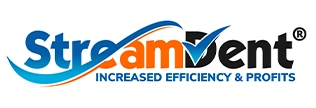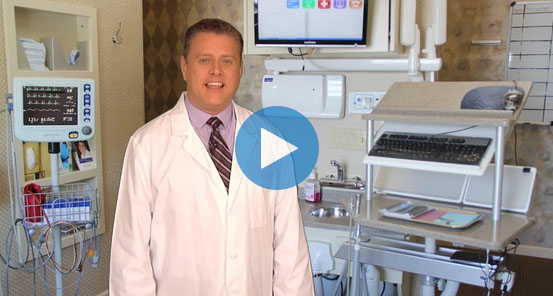Start Your New Patient Experience Off Right
When your new patient arrives, they will usually be the only patient scheduled at the time that your business assistant doesn’t recognize. The savvy business assistant can be ready to make a great first impression. When she sees the new face, she’s ready with a greeting such as “hi, you must be Jennifer. I’m Suzanne, we talked on the phone earlier. Please make yourself at home. May I get you a drink?”
After the patient has filled out any necessary forms, the appointment coordinator radios the dental assistant to verify they are ready. Since the business assistant already has a new relationship with the patient, she gives the patient a tour of the office, then escorts the patient to the dental treatment room and introduces the dental
assistant.
Here’s an example of a script for an office tour that positions your practice in the best positive light. (Please click on image to view the detailed script.)
For information on StreamDent, contact us at 502‐509‐1570, or visit us at www.StreamDent.com.
 Over the last decade, written patient consent forms have become the standard of care in dentistry, and our state dental boards now expect us to use written consents. Proper use of consent forms also help manage patient expectations and better protect practitioners from some lawsuits.
Over the last decade, written patient consent forms have become the standard of care in dentistry, and our state dental boards now expect us to use written consents. Proper use of consent forms also help manage patient expectations and better protect practitioners from some lawsuits.
It is not adequate to have a patient just sign a written consent form without explaining the consent issues to the patient and taking time to answer their questions. Even if allowing the patient to read a consent form was legally acceptable, the time a patient takes to read some consent forms can take a considerable amount of time in our busy offices.
The standard of care also requires that the dentist be ultimately responsible for communicating consent issues, or training the team to communicate the basic issues with a follow-up by the dentist. When I’m training an office in the use of systems and protocols, I teach the dental assistants to review these consent issues with customizable scripts from StreamDent, using the B.R.A.N. format.
By briefly discussing the Benefits, Risks, Alternatives and what occurs if the patient has No treatment in the scripts, the dental assistant or hygienist can quickly cover the most important areas of consent very efficiently with the patient. When the doctor enters the room, a question such as “what questions do you have for me about the consent form Becky reviewed with you,” followed by amplifications or additions of any specific risks related to the patient’s specific circumstance.
At the end of the exam after the dentist has talked with the patient about their conditions, a handoff is then given to the dental assistant that will walk the patient to the business office.
In many cases, instead of a 5-10 minute ordeal with paperwork, the consent forms can be reduced as little as 60-90 seconds.
To check out StreamDent’s consent form scripts in a web demo and see how StreamDent, the ultimate SOP manual, can help your entire office run more efficiently with less stress, call us today at 502-509-1570, or click here.
In a dental office, communication is key. Today I want to share a technique that improves communication between the office team, all while motivating the patient simultaneously.
Several years ago, psychologists working in a hospital setting were researching ways to improve patients’ outcomes after surgery. They first looked at how patients recovered when the surgeon came to their bedside after surgery to tell them that the surgery went well. Next, they modified their technique. They had the surgeon have a conversation with a next of kin just close enough that the patient could overhear the conversation. The patients that overheard the conversation were discovered to make a faster recovery than the ones that listened to the surgeon in person.
 This concept of overhear psychology can be applied in several settings in the dental office to better motivate our patients to improve their dental health. The first setting we use overhear psychology is during a patient’s clinical exam. After reviewing the medical and dental histories, the dental assistant takes time for the patient to review their own clinical photographs. After the assistant has guided the patient to see some obvious problems on the photos and x-rays, the patient overhears the dental assistant tell the doctor about the problems they have already uncovered.
This concept of overhear psychology can be applied in several settings in the dental office to better motivate our patients to improve their dental health. The first setting we use overhear psychology is during a patient’s clinical exam. After reviewing the medical and dental histories, the dental assistant takes time for the patient to review their own clinical photographs. After the assistant has guided the patient to see some obvious problems on the photos and x-rays, the patient overhears the dental assistant tell the doctor about the problems they have already uncovered.
At the end of the exam after the dentist has talked with the patient about their conditions, a handoff is then given to the dental assistant that will walk the patient to the business office.
 Let’s say that our patient, Linda, has caries on a molar that the patient told us is sensitive to cold.
Let’s say that our patient, Linda, has caries on a molar that the patient told us is sensitive to cold.
The doctor might use a script like: “Becky, as you walk Linda up for checkout, please tell Mary to try to get Linda scheduled as soon as possible for her next appointment. I’m hoping we can perform the procedure so that we can help Linda avoid the need for root canal therapy where her tooth has been sensitive.” The patient, of course, overhears the entire conversation.
Like passing a baton in a relay race, the next handoff occurs at the checkout station in the business office. Becky repeats nearly the same handoff to the receptionist, Mary. “Mary, Dr. Moorhead recommended we get Linda in as soon as possible for her next appointment. She’s having sensitivity on her upper molar and Dr. hopes that by working on it as soon as possible, we’ll hopefully avoid a root canal for her.”
When Mary hears that conversation, Linda has not only had her urgency reinforced a couple of times, but in addition, Mary is empowered with information that will be helpful in a few days when she confirms Linda’s appointment. “Hi, Linda, this is Mary at Dr. Moorhead’s office. We’re looking forward to seeing you for your appointment tomorrow at 3 PM. Dr. Moorhead is going to work on that sensitive tooth so we can hopefully just have to do a filling.”
At your next team training session, discuss how handoffs could help motivate your patients and provide a consistent way to communicate.. And talk to your doctor about the ways your office could improve productivity and decrease stress by implementing systems and checklists throughout the office using StreamDent, the ultimate dental SOP manual. You can reach us at 502.509.1570, or CLICK HERE to request a web demo.
 Time Out !!
Time Out !!
When you hear the phrase “time out,” the first thing you probably think about is a sports event, or if you’re a parent, you might think of discipline for your child. Generally not something in your dental SOP manual.
Today, we’re looking at a different kind of time out. Just like time-out periods in sports activities are used to pause and plan strategy, a time out in dentistry and medicine is a planned pause before the start of treatment to focus on safety and communication about the patient.
Time outs have been used in medicine for several years. They were first used in surgery, with the surgical team verifying such areas as:
- the patient’s name
- their date of birth
- the consent form had been signed
- drug allergies
- the kind of surgery being performed
Planned Time-Outs in Dentistry
In dentistry, we fortunately don’t often have the life or death issues that are faced in a hospital, but mistakes end up costing us time, add to our stress, and can sometimes cause us to achieve less than desired results.
The most natural time for a time out for our procedures is anytime before someone picks up a needle for an injection, including local anesthesia or the start of an IV sedation.
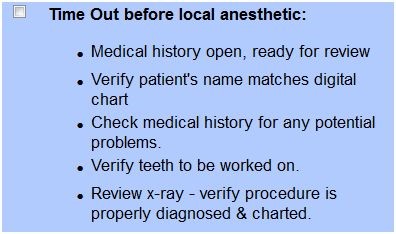 Here’s an example of the time out we recommend in StreamDent before local anesthesia:
Here’s an example of the time out we recommend in StreamDent before local anesthesia:
Talk over time-outs at your next team training session. And talk to your doctor about the ways your office could improve productivity and decrease stress by implementing systems and checklists throughout the office using StreamDent, the ultimate dental SOP manual. You can reach us at 502.509.1570.
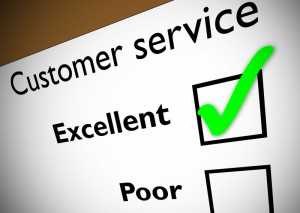 Tell me if this sounds familiar? You took your entire team to a continuing education course on improving customer service. It might have been presented by someone from the Ritz Carlton hotel chain or the Disney Institute. As a dentist with several years experience, you know these courses can really inspire teams. They returned from the courses and you saw them improve. Then gradually over time, you saw them regress. You know they definitely got something out of the course(s), and you know they understand all of the concepts. But in the hectic world of dental offices, you also know they don’t always follow through. Dental office customer service must be built into your systems.
Tell me if this sounds familiar? You took your entire team to a continuing education course on improving customer service. It might have been presented by someone from the Ritz Carlton hotel chain or the Disney Institute. As a dentist with several years experience, you know these courses can really inspire teams. They returned from the courses and you saw them improve. Then gradually over time, you saw them regress. You know they definitely got something out of the course(s), and you know they understand all of the concepts. But in the hectic world of dental offices, you also know they don’t always follow through. Dental office customer service must be built into your systems.
The problem is not that they don't know what to do. The problem is their lack of consistency. And in customer service, it’s lack of consistency that hurts practices the most. If patients have a fabulous experience, and even go home and brag about how well they were treated, but then don’t see that same level of service on their next visit, they feel let down.
So, what can we do to best maintain consistency? We can do it through the use of systems. But in the typical dental office, systems on cards or in notebooks too often get filed away and forgotten.
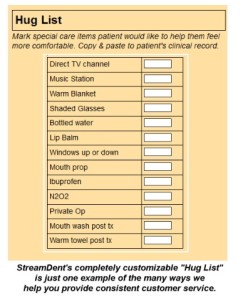 StreamDent is designed to overcome all of these obstacles. StreamDent’s cloud based software gives your team access to checklists to run every aspect of your practice smoothly and efficiently throughout the day.
StreamDent is designed to overcome all of these obstacles. StreamDent’s cloud based software gives your team access to checklists to run every aspect of your practice smoothly and efficiently throughout the day.
Patients will notice how procedures run more smoothly, and they’ll notice they are given the same high level of customer service at every visit.
Dental offices across the country are discovering the StreamDent difference. Turn things around by calling today to find out how StreamDent will help you and your team achieve their very best. You can reach us at 502.509.1570.
Many years ago, when a doctor or dentist made a recommendation, the patient almost always accepted their expertise and proceeded with the procedure. A lot has changed since then. With the advent of the internet, patients may even want to go home and do their own research before making a treatment decision. One of the reasons patient hesitate is because they feel the doctor will benefit financially and feel they must look out for their own self interest.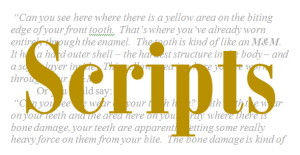
In training dental offices, you probably already used the phrase co-diagnosis to describe the process where the patient is guided through a self-discovery of their problems. Technology now helps us tremendously in this process, using digital photographs, intra-oral cameras and digital radiographs.
I like to take digital photographs early in the examination appointment so that the photos can be uploaded and the patient can see their actual conditions and begin owning their problems before the doctor performs his/her exam. Most patients expect far less problems than are actually present. By seeing the evidence first hand, their self discovery improves case acceptance.
- Do you see anything you're concerned about?
- Is there anything you'd like to change about your smile?
- Anything else?
- Anything else? (Keep repeating this question until the patient stops!)
As the team member guides the patient through co-diagnosis, dental office scripts and analogies provide a great way for dental assistants to explain obvious dental situations to patients. Patients understand analogies, or so-called word pictures better than straight facts. I saw this, as dental assistants worked with me for several years, they were using the same word pictures that I use. When we finally realized that new dental assistants could learn the same scripts more quickly if they were in written form, it first met with resistance because it was difficult to memorize the scripts. When we added the scripts to StreamDent software so that the dental assistant could be able to glance at the script on a tablet computer or a monitor behind the patient, their use increased dramatically.
Dental Office Scripts
Below is an example of a script we use during the examination process.
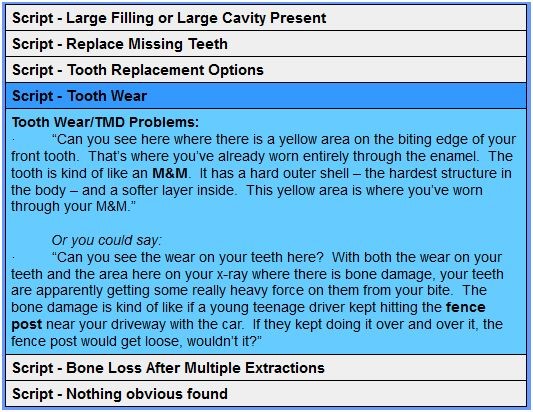
To see the script we use for our new patient office tours, click here.
As a consultant, you know scripts are a valuable tool that are too often unused. It's difficult to get team members to memorize scripts where they can be used effectively. I invite you to look at how using StreamDent, the ultimate dental SOP manual, can overcome those problems. You can reach us at 502.509.1570.
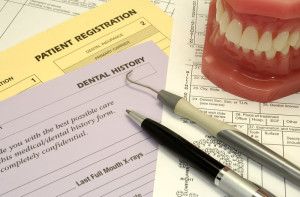 The way you design your medical and dental history forms definitely affects efficiency. This article focuses on helping you save time and gather the best information to diagnose and motivate your patients.
The way you design your medical and dental history forms definitely affects efficiency. This article focuses on helping you save time and gather the best information to diagnose and motivate your patients.
First, let’s briefly discuss the availability of online forms. As you know, most practice management systems now have online forms available. By making the forms available to patients online, the practice can save valuable chair-time by getting account registration, medical and dental histories filled out in advance. To save that chair-time, though, the forms must be designed for easy patient use. If teams often find that their patients fill out the form incorrectly or omit needed information, a redesign is likely indicated.
When helping create or editing medical and dental histories, consider designing the questions so that a yes answer requires the doctor’s attention. This can speed the process of reviewing the form after all information has been obtained from the patient. As an example, change the question “are you satisfied with the color of your teeth?” to “would you like whiter teeth?” For the best chance to understand the patient’s needs and priorities, help the client use several open-ended questions. Examples:
- What are your biggest concerns you want us to address during your visit?
- Overall, what is most important to you concerning your teeth?
- If you could change anything about your mouth, teeth or smile, what would it be?
Another way to save doctor time is to include summary sections in the medical and dental history forms to summarize information. For example, by using a large text box after the long list of yes or no questions about medical problems, the dental assistant can type out each medical problem, ask and record information to follow-up the condition, and list any medications the patient takes for that condition as well. Below is an example of this type of summary:
- Heart Murmur with regurgitation - no premed required.
- Dislipidemia – Simvastatin 10 mg qd hs
- Hypertension- Lisinopril 10 mg qd hs. BP 118/74 RAS
- Reflux – well controlled. Nexium 20 mg qd
- Drug allergies - Erythromycin, Cephalexin
- Tobacco hx - non-user
To see Dr. Moorhead's sample questionnaires, click here.
 Looking for ways to systematize your dental office? In the book "The Checklist Manifesto" by Atul Gawande, MD, Dr. Gawande talks about the advantages of using discipline in our work day. Let’s face it, we’re human and prone to mistakes. Gawande shows how systems and checklists can reduce mistakes, increase efficiency and decrease stress.
Looking for ways to systematize your dental office? In the book "The Checklist Manifesto" by Atul Gawande, MD, Dr. Gawande talks about the advantages of using discipline in our work day. Let’s face it, we’re human and prone to mistakes. Gawande shows how systems and checklists can reduce mistakes, increase efficiency and decrease stress.
Even the Journal of the American Dental Association (JADA) agrees. In an article published in August 2010, Harold M. Pinsky, DDS, a dentist who practices part time and also works as an airline pilot states “to enhance safety, practitioners must implement forward-thinking strategies. Because human error is inevitable, threat and error management techniques are needed to help identify and trap error before it develops into unexpected outcomes. Risk analysis increases situational awareness of potential dental error. Efficiency increases with early error detection.”
If you already have a good handle on discipline and have the time, energy and drive to develop your own systems and checklists for your practice, here are a few guidelines that make the process easier:
• Checklists are best broken into small pieces.
• Items that are frequently repeated in many procedures can be omitted or hidden. When I develop systems for StreamDent's online procedures manual, I hide the frequent lists so that a newer trainee can have access, and so an experienced user isn’t bogged down by unnecessary detail.
• While a trainee working to develop competency should follow a checklist the last detail, an experienced team member can set up for a procedure, then review the checklist as a fail-safe to avoid missing small details.
As I develop checklists for dental procedures, I like to include items to bring into the operatory, room setup (steps unique to the procedure), what to do when the patient is seated, what to say in order to review the consent form, postop instructions, and steps to be completed before the patient is dismissed.
more about how StreamDent works
